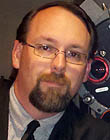|
|
This topic comprises 2 pages: 1 2
|
|
Author
|
Topic: recommendation for a good Oscilloscope
|
|
|
|
|
|
|
|
|
Dennis Benjamin
Phenomenal Film Handler

Posts: 1445
From: Denton, MD
Registered: Feb 2002
|
 posted 07-17-2018 04:28 PM
posted 07-17-2018 04:28 PM





Or you could build your own:
The link
An oscilloscope is a laboratory instrument commonly used to display and analyze the waveform of electronic signals. In effect, the device draws a graph of the instantaneous signal voltage as a function of time.
Oscilloscopes are used in the sciences, medicine, engineering, and telecommunications industry. Oscilloscopes are very essential and best friend for students, maker, hobbyist and electronics enthusiast. While a digital multimeter can help you measure steady state and RMS (Root-Mean-Square) voltages, the oscilloscope can not only measure peak-to-peak voltages, but more importantly provide timing information on your signal. For instance, have you ever been working with an Arduino controlling a servo motor that has to have just the right pulse width modulation in order to spin clockwise instead of counter-clockwise? During your programming, you may have wondered just how close the pulse width was to what was needed. With an oscilloscope you can measure these pulses. When dealing with analog signals, you can use an oscilloscope to see how close you are to the frequency you need or measure what frequency you need to filter. With so many digital electronic projects, timing between signals is extremely important. Therefore, having an oscilloscope is essential but unfortunately they are very expensive.
You can find several DIY oscilloscope in Internet and some links are provided below:
1. PC sound card based oscilloscope
http://homediyelectronics.com/projects/howtomakeafreesoundcardpcoscilloscope/
https://www.instructables.com/id/Use-Your-Laptop-as-Oscilloscope/
http://makezine.com/projects/sound-card-oscilloscope/
2. Arduino based oscilloscope
https://www.instructables.com/id/Arduino-Oscilloscope-poor-mans-Oscilloscope/
http://www.miupanel.com/Projects/Arduino-Advanced-Oscilloscope
https://www.instructables.com/id/Girino-Fast-Arduino-Oscilloscope/
https://www.instructables.com/id/DIY-USB-OSCILLOSCOPE-IN-A-MATCHBOX/
3. CRT TV based oscilloscope
https://www.instructables.com/id/Fully-Functional-Television-Oscilloscope/
https://www.instructables.com/id/Mini-TV-Oscilloscope/
https://www.instructables.com/id/How-To-Make-A-CRT-TV-Into-an-Oscilloscope/
4. Smart phone based oscilloscope
https://www.instructables.com/id/OscilloPhone-Use-your-Smartphone-as-an-Oscilloscop/
https://www.instructables.com/id/A-Preamplifier-for-Smartphone-Oscilloscopes/
http://projectproto.blogspot.com/2010/09/android-bluetooth-oscilloscope.html
5. Raspberry Pi based oscilloscope
https://www.instructables.com/id/PiMSO-A-Raspberry-Pi-based-Wi-Fi-Oscilloscope/
http://www.open-electronics.org/turn-your-raspberry-pi-in-an-oscilloscope-with-bitscope/
All of those oscilloscopes have their own pros and cons. Most PC and Arduino based oscilloscope can not sample more than several kilohertz. Sometimes PC based oscilloscope can burn your computer motherboard. Previous Raspberry Pi based oscilloscope required special hardware. I will show you step by step guide how to build a Raspberry Pi based oscilloscope without special hardware. I would like to thank Mr. Daniel Pelikan who first published the idea in the MagPi magazine, Issue 24.
| IP: Logged
|
|
|
|
|
|
Marcel Birgelen
Film God
Posts: 3357
From: Maastricht, Limburg, Netherlands
Registered: Feb 2012
|
 posted 07-18-2018 07:30 PM
posted 07-18-2018 07:30 PM




Really?
For simple audio measurement, do yourself a pleasure and go for a digital oscilloscope.
There might still be a very limited amount of applications were an analog scope might outperform a digital one, but for anything someone usually does in this field of work, I can't think of a single one of them.
A digital scope has numerous advantages:
- They're much compacter and lighter than their analog counterparts, because today they all use LCD screens instead of heavy CRTs.
- Since they're far less power hungry, there are lots of models that can run on battery.
- A digital scope can store the data it captured, you can export this data and often there are functions to load in some external reference data.
So, now the disadvantages:
- All digital scopes have some latency, although I still need to find an application were this latency really creates a problem...
- A digital scope uses digital samples, so the curve it plots is not as perfectly smooth as the analog one. It also displays the curves on a raster display, not on a CRT screen with directly driven electron beam. Given sufficient resolution though, this is almost never a problem.
In order to go for accuracy, I'd always go for one of the known brands, not for some self-built RasPi project or some hardware-software interface. The "big brand" oscilloscopes usually come pre-calibrated and pre-tested, so you can ensure some levels of accuracy.
| IP: Logged
|
|
|
|
|
|
|
|
|
|
|
|
|
|
|
|
|
|
All times are Central (GMT -6:00)
|
This topic comprises 2 pages: 1 2
|
Powered by Infopop Corporation
UBB.classicTM
6.3.1.2
The Film-Tech Forums are designed for various members related to the cinema industry to express their opinions, viewpoints and testimonials on various products, services and events based upon speculation, personal knowledge and factual information through use, therefore all views represented here allow no liability upon the publishers of this web site and the owners of said views assume no liability for any ill will resulting from these postings. The posts made here are for educational as well as entertainment purposes and as such anyone viewing this portion of the website must accept these views as statements of the author of that opinion
and agrees to release the authors from any and all liability.
|

 Home
Home
 Products
Products
 Store
Store
 Forum
Forum
 Warehouse
Warehouse
 Contact Us
Contact Us




 Printer-friendly view of this topic
Printer-friendly view of this topic















